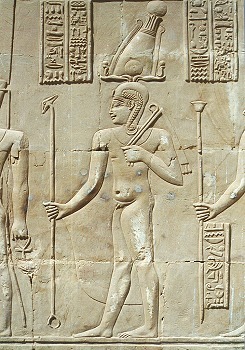
خونسو هو رب القمر في معتقدات قدماء المصريين؛ هو ابن آمون وموت ويكون معهما ثالوث طيبة. وأهم منطقة لديانة خونسو كانت تلك التي تضم مجموعة آمون في معبد الكرنك. واشتق الاسم "خونسو" من كلمة "خونس" التي تعنى في اللغة المصرية القديمة "يتجول"؛ وهكذا كان التصور بالنسبة لذلك الرب" المتجول" وهى صفة أوحت بها حركة القمر عبر السماء. وكان القمر محددا هاما للتوقيت, وبذلك أصبح "خونسو" رب (الزمن). وبهذه الصفة, كانت له القدرة على تحديد عدد السنين التي سوف يعيشها إنسان أو يحكم خلالها ملك. وارتبط"خونسو" بأرباب كثيرة أخرى, وخاصة غيرة من أرباب القمر, وفى المقدمة الرب "تحوت". ووفق الأساطير المصرية القديمة, كان الاعتقاد بأن آمون ورب الشمس "رع" كانا يتقاربان معا, وتبعا لذلك نمت علاقة وطيدة بين "خونسو" ابن آمون و"شو" ابن رب الشمس "رع". وتمحضت تلك الرابطة عن ظهور الرب"خونسو- شو" الذي تقول عنه النصوص الجنائزية بأنه يساعد "البا"; للمتوفى في رحلتها إلى السماء. وفى عصر الدولة الحديثة أصبح خونسو يرتبط مباشرة برب الشمس نفسه, ربما بصفه خونسو رب ضوء القمر, في صورة خونسو- رع"؛ وباعتبار أن القمر هو الشمس الليلية. وكان "خونسو" يعبد في الكرنك بصفته "نفرحوتب في طيبة ". وكان خونسو "كطفل", يرتبط أيضا بحورس الطفل؛ لذلك كان يصور أحيانا بخصلة الشعر الجانبية, واقفا على تمساح. ويمكن أن يقارن هذا الوضع بما يصور عليه حورس نفسه على اللوحات السحرية. وكان الاثنان يعدان معبودين قادرين على طرد الشر وشفاء الأمراض. وفسرت تلك القدرة لدى "خونسو", رب القمر, من خلال الاعتقاد بأن الأمراض كانت تعزى إلى تأثير القمر وربط الإغريق بين "خونسو" وهيراقليس ابن زيوس. ويقابل زيوس عند الإغريق بالمعبود آمون عند قدماء المصريين ويأتي هذا الربط الأخير من ارتباط "خونسو" نفسه بالرب "شو" ابن الإله آمون, والمسئول عن ثبات السماء.